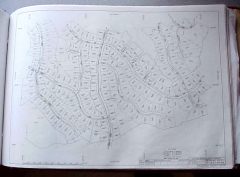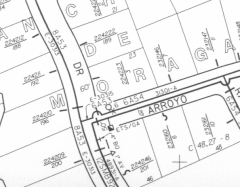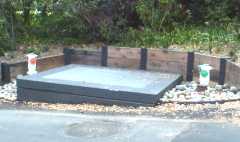© 2000 Capt. Willis Lamm, Water Supply Officer, Moraga-Orinda (CA) Fire DistrictBackground Criteria Storage Distribution Hyd. Design Placement Installation Codes & Markings Applications Codes & Standards
|
| WATER DISTRIBUTION SYSTEMS |
|
Getting water distributed adequately and reliably to points of use is a
product of sound engineering practices and an understanding of water distribution
principles to support fire fighting operations.
Grid Systems The most reliable means to provide water for fire fighting is by designing redundancy into the system. There are several advantages gained by laying out water mains in a grid, with feeder and distributor mains interconnecting at roadway intersections and other regular intervals.
|
Water system map book
|
|
Each geographic point of the distribution system should be supplied by
primary feeders which are typically 16 in. (400 mm) in diameter. Secondary
feeders which are typically 12 in. (300 mm) in diameter would be appropriate
to supply specific neighborhoods. 8 in. (200 mm) diameter distributor mains
would typically be used to supply water to individual streets and to the
fire hydrants on those streets. Hydrant laterals should not be less than
6 in. (150 mm).
Street valves should be provided at every junction for all mains branching from those junctions. In this manner any single section of main can be taken out of service in the event of breakage and for repair without disrupting water service beyond the affected section of pipe. By having the system completely interconnected, even the loss of a section of primary feeder would not result in a complete loss of water delivery as the other components of the system would provide a "bypass" around the outage. Specific pipe sizes used may vary from these standards based on local conditions and projected demands upon the system. In any event, no distributor mains should be smaller than 6 in. (150 mm) and unless they are cross-connected into the grid at least every 600 ft. (180m), they should be no less than 8 in. (200mm) in diameter. Construction Materials Sleection of pipeline construction materials may vary based on a number of factors including geological conditions, operating pressures and locally available. Concrete lined steel is most adequate for feeder mains while PVC provides reliable service for distributor mains. Additionally, PVC is easy to work with with respect to adding service and hydrant connections after the mains have been installed. | |
|
Regulator Systems
It may be necessary to regulate pressure to small, low lying areas where installation of separate reservoirs is not feasible. These regulator systems are reliable when properly designed. To prevent upsystem damage from "water hammer," pressure regulation on water mains should be accomplished by means of a parallel array of regulators known as a regulator set. Ranging in size from 2 in. (51mm) to 6 in (150mm), the sets should be configured so that the smaller regulators open first, then the larger regulators open in sequence as demand increases, and then the regulators close in sequence as demand decreases in the portion of the system being regulated.
|
Typical regulator vault
|
| Continue to Part 4 |
Return to Part 2
Return to Information Section
Return to Water Supply Page
Background Criteria Storage Distribution Hyd. Design Placement Installation Codes & Markings Applications Codes & Standards
|


 (Two fire hydrants are installed,
(Two fire hydrants are installed,